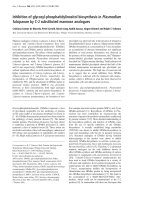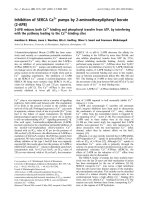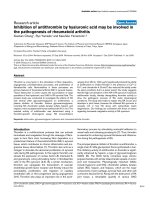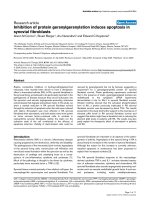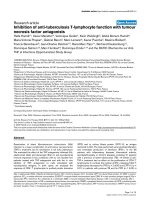Báo cáo y học: "Inhibition of HIV-1 replication in primary human monocytes by the IκB-αS32/36A repressor of NF-κB" docx
Bạn đang xem bản rút gọn của tài liệu. Xem và tải ngay bản đầy đủ của tài liệu tại đây (1.03 MB, 8 trang )
BioMed Central
Page 1 of 8
(page number not for citation purposes)
Retrovirology
Open Access
Research
Inhibition of HIV-1 replication in primary human monocytes by the
IκB-αS32/36A repressor of NF-κB
Camillo Palmieri
1
, Francesca Trimboli
1
, Antimina Puca
2
, Giuseppe Fiume
2
,
Giuseppe Scala
1,2
and Ileana Quinto*
1,2
Address:
1
Department of Clinical and Experimental Medicine, University of Catanzaro "Magna Graecia", Via T. Campanella 115, 88100 Catanzaro,
Italy and
2
Department of Biochemistry and Medical Biotechnology, University of Naples "Federico II", Via S. Pansini 5, 80131 Naples, Italy
Email: Camillo Palmieri - ; Francesca Trimboli - ; Antimina Puca - ;
Giuseppe Fiume - ; Giuseppe Scala - ; Ileana Quinto* -
* Corresponding author
Abstract
Background: The identification of the molecular mechanisms of human immunodeficiency virus
type 1, HIV-1, transcriptional regulation is required to develop novel inhibitors of viral replication.
NF-κB transacting factors strongly enhance the HIV/SIV expression in both epithelial and lymphoid
cells. Controversial results have been reported on the requirement of NF-κB factors in distinct cell
reservoirs, such as CD4-positive T lymphocytes and monocytes. We have previously shown that
IκB-αS32/36A, a proteolysis-resistant inhibitor of NF-κB, potently inhibits the growth of HIV-1 and
SIVmac239 in cell cultures and in the SIV macaque model of AIDS. To further extend these
observations, we have generated NL(AD8)IκB-αS32/36A, a macrophage-tropic HIV-1 recombinant
strain endowed to express IκB-αS32/36A.
Results: In this work, we show that infection with NL(AD8)IκB-αS32/36A down-regulated the
NF-κB DNA binding activity in cells. NL(AD8)IκB-αS32/36A was also highly attenuated for
replication in cultures of human primary monocytes.
Conclusions: These results point to a major requirement of NF-κB activation for the optimal
replication of HIV-1 in monocytes and suggest that agents which interfere with NF-κB activity could
counteract HIV-1 infection of monocytes-macrophages in vivo.
Background
HIV-1 infection is characterized by a long period of clini-
cal latency followed by the development of acquired
immunodeficiency syndrome, AIDS. During latency and
when viral replication is being controlled in patients
treated with antiretroviral therapy, HIV-1 is present in cel-
lular reservoirs and continues to replicate, with each ensu-
ing round of replication giving rise to escape mutants,
which further replenish viral reservoirs [1,2]. This grim
picture calls for novel targeted therapies for eradicating
virus-infected cells and for preventing new infections.
Initial infection in vivo by HIV-1 is thought to occur in
CD4-positive, CCR5-positive lymphocytes and mono-
cytes. Accordingly, when HIV-1 envelope protein in its oli-
gomerized g160 form contacts the cell surface receptor a
signalling cascade is triggered that results in transcrip-
tional activation of specific gene arrays, such as the
Published: 21 December 2004
Retrovirology 2004, 1:45 doi:10.1186/1742-4690-1-45
Received: 13 December 2004
Accepted: 21 December 2004
This article is available from: />© 2004 Palmieri et al; licensee BioMed Central Ltd.
This is an Open Access article distributed under the terms of the Creative Commons Attribution License ( />),
which permits unrestricted use, distribution, and reproduction in any medium, provided the original work is properly cited.
Retrovirology 2004, 1:45 />Page 2 of 8
(page number not for citation purposes)
inflammatory cytokines IL-1 β, IL-6, IL-8, TNF-α, TGF-β;
these cytokines, in turn, function to enhance the transcrip-
tional activity of the proviral long terminal repeat (LTR)
promoter [3,4]. This cytokine-driven inflammatory-like
setting is mediated molecularly by the NF-κB family of
transcription factors [5,6]; thus, it serves to reason that
preventing NF-κB activation would attenuate HIV-1 repli-
cation. Indeed, the LTR of HIV-1 does contain two tandem
NF-κB sites [7] and three repeated Sp1 sites [8] upstream
of the TATAA box with an additional NF-κB site located in
the 5' untranslated region of viral genome [9]. Both sets of
NF-κB sequences enhance HIV-1 transcription in response
to various signals [9]. However, the Sp1 sites and TATAA
box can redundantly sustain the Tat-mediated transactiva-
tion of the HIV-1 LTR in the absence of NF-κB sites [10].
It is controversial whether NF-κB cellular factors are
required for the HIV-1 replication. Mutant HIV-1 carrying
deletions or base-pair substitutions in the NF-κB enhancer
in the LTR have been shown to be either competent or
incompetent for replication [11-13]. These divergent
observations are likely explained by differing cellular con-
texts, such as primary cells versus immortalized cell lines,
and varying levels of cellular activation.
IκB inhibitors regulate NF-κB activity [14]. In response to
activating stimuli, IκB proteins become phosphorylated,
ubiquinated and degraded by proteasomes. This releases
cytoplasmic-sequestered NF-κB to enter the nucleus to
activate the transcription of responsive genes [14]. The
mutant IκB-αS32/36A is defective for serine 32- and ser-
ine 36-phosphorylation and is resistant to proteolysis.
IκB-αS32/36A acts as a potent inhibitor of the NF-κB-
dependent gene transcription, including those from the
HIV-1 genome [15]. To verify the requirement of NF-κB in
the replication of HIV-1 in primary cells, we previously
designed HIV-1 and SIV molecular clones containing the
IκB-αS32/36A cDNA positioned into the nef region of the
respective viral genome [16,17]. We found that these
recombinant viruses were highly attenuated for replica-
tion in T cell lines as well as in human and simian PHA-
activated peripheral blood mononuclear cells, PBMCs
[16,17]. These findings supported an interpretation that
in these cellular contexts NF-κB is required for efficient
viral replication. We also showed that a recombinant SIV
which expressed IκB-αS32/36A inhibitor was also highly
replication attenuated in vivo in rhesus macaque [17].
Here, we have extended our analysis of IκB-αS32/36A
function in HIV-1 replication to primary monocytes. We
report that a macrophage-tropic derivative of NL4-3 strain
that expresses the proteolysis-resistant IκB-αS32/36A
inhibitor of NF-κB replicated poorly in cultured primary
human monocytes.
Results
Construction of pNL(AD8)I
κ
B-
α
S32/36A
To generate a macrophage-tropic HIV-1 expressing the
IκB-αS32/36A cDNA fused to the FLAG epitope, the
CXCR4-tropic envelope of pNLIκB-αS32/36A [16] was
replaced with the CCR5-tropic envelope from pNL(AD8)
[18]. Briefly, the 2.7 Kb EcoR1-BamH1 fragment of
pNL(AD8) was religated to the 13.1 Kb EcoR1-BamH1
fragment of pNLIκB-αS32/36A or pNLIκB-antisense, thus
generating pNL(AD8)IκB-αS32/36A and pNL(AD8)IκB-
antisense, respectively (Fig. 1A). Both molecular clones
are Nef-minus because our cloning strategy deleted the
first 39 amino acids from the N terminus of Nef and engi-
neered a translational frameshift into the remaining Nef-
encoding codons [16]. The respective molecular clones
were transfected into 293T cells to analyse for the expres-
sion of HIV-1 proteins and IκB-αS32/36A polypeptide by
immunoblotting (Fig. 1 B, C). As expected the IκB-αS32/
36A-FLAG protein was expressed by pNL(AD8)IκB-αS32/
36A (Fig. 1C, lane 4).
Inhibition of NF-
κ
B activity by pNL(AD8)I
κ
B-
α
S32/36A
To assess the functional impact of IκB-αS32/36A
expressed from the recombinant NL(AD8) genome, 293T
cells were transfected individually with pNL(AD8),
pNL(AD8)IκB-αS32/36A or pNL(AD8)IκB-antisense, and
the respective nuclear extracts were evaluated for NF-κB
(Fig. 2A) and Sp1 DNA binding activity (Fig. 2B). A signif-
icant reduction in NF-κB DNA binding activity was
observed upon transfection of pNL(AD8)IκB-αS32/36A
(Fig. 2A, lane 5) as compared to the other viral transfec-
tions (Fig. 2A, lanes 3,4). The specificity of the IκBαS32/
36A-mediated inhibition of NF-κB was verified by the
demonstration that Sp1 binding to DNA was unaffected
(Fig. 2B). These results support the interpretation that
IκBαS32/36A expressed from the recombinant viral
genome functionally inhibited NF-κB activity.
Attenuation of pNL(AD8)I
κ
B-
α
S32/36A in primary
monocytes
We next analyzed the replication properties of the recom-
binant HIV-1 genomes in cultured human monocytes
from different individuals. Based on normalized amounts
of input virus, we found that NL(AD8)IκB-αS32/36A was
highly attenuated for replication when compared to
NL(AD8) and NL(AD8)IκB-antisense (Fig. 3 A-B). Accord-
ingly, virus-induced syncitium formation was also
strongly inhibited in monocytes infected with
NL(AD8)IκB-aS32/36A (Fig. 4 A, B). Taken together, our
results underscore a critical contribution of NF-κB to HIV-
1 growth in monocytes.
Discussion
Substantial numbers of monocytes are preserved in
infected individuals even at later clinical stages of AIDS,
Retrovirology 2004, 1:45 />Page 3 of 8
(page number not for citation purposes)
when T cell numbers are dramatically reduced. Consist-
ently, in animal models of HIV-1 infection, monocytes are
the major reservoir after acute depletion of CD4-positive
T cells [19,20]. This indicates that these cells are long last-
ing infected moieties that shuttle from mucosal sites to
lymph nodes and could function as a major HIV-1 reser-
voir in vivo. In addition, monocytes are programmed to
produce a large amount of inflammatory cytokine, includ-
Genome structure and expression of recombinant pNL(AD8)IκB-αS32/36A and pNL(AD8)IκB-antisense molecular genomesFigure 1
Genome structure and expression of recombinant pNL(AD8)IκB-αS32/36A and pNL(AD8)IκB-antisense
molecular genomes. Panel A shows the structure of pNL(AD8) derivatives that carry the IκB-αS32/36A-FLAG insert into
the nef region in sense (pNL(AD8)IκB-αS32/36A) or antisense (pNL(AD8)IκB-antisense) orientations. Panel B shows the
immunoblot analysis using hyperimmune AIDS patient serum of total extracts (10 µg) from 293T cells 24 hours after transfec-
tion with the indicated viral plasmids (10 µg). Panel C shows the immunoblot analysis using an anti-FLAG monoclonal antibody
of total extracts (10 µg) from 293T cells 24 h after transfection with the indicated viral plasmids (10 µg).
Retrovirology 2004, 1:45 />Page 4 of 8
(page number not for citation purposes)
ing IL1-β, IL-6, TNF-α, which are strong inducers of HIV-
1 replication [5]. Indeed, HIV-1 envelope binding to
CCR5 receptor activates an intracellular signalling cascade
that promotes high levels of transcription factors, includ-
ing NF-κB, which sustain the initial rounds of viral repli-
cation and induce the production of inflammatory
cytokines which activate surrounding cells to become
more susceptible to virus infection [3,4].
Based on the published literature, the role of NF-κB in
HIV-1 replication has been controversial [13,16,21]. For
instance, the deletion of NF-κB binding sites from HIV-1
Reduced NF-κB DNA binding activity in cells transfected with pNL(AD8)IκB-αS32/36AFigure 2
Reduced NF-κB DNA binding activity in cells transfected with pNL(AD8)IκB-αS32/36A. Panel A shows the NF-κB
binding activity of nuclear extracts (5 µg) from 293 T cells transfected with the indicated viral plasmids (10 µg) or were mock-
transfected. Panel C shows the Sp1 binding activity of the same nuclear extracts as in panel A. Binding competitions were per-
formed with 100-fold molar excess of the respective unlabelled oligonucleotide.
Retrovirology 2004, 1:45 />Page 5 of 8
(page number not for citation purposes)
and SIV LTRs [22] has suggested that NF-κB activity may
not be required for HIV-1 LTR-directed transcription.
Moreover, deletion of NF-κB sequences in the LTR has
also been reported not to affect HIV-1 replication in
defined cellular settings [11,12]. These latter studies relied
on short-term infections of immortalized cells that may
not express a physiologic concentration of transcription
factors. To address this issue, we have developed a novel
HIV-1 strain, NL(AD8)IκB-αS32/36A, which was engi-
neered to express a proteolysis-resistant IκBαS32/36A,
and is a strong inhibitor of NF-κB activity. This recom-
binant virus expresses the envelope of the AD8 strain, a
macrophage-tropic virus. Our findings show that
NL(AD8)IκB-αS32/36A replication profile is different
from that of the NL(AD8)IκB-antisense control.
NL(AD8)IκB-αS32/36A failed to produce a productive
infection in primary monocytic cells over a thirty-days
acute infection (Fig. 3). These results were correlated with
a strong inhibition NF-κB activity in NL(AD8)IκB-αS32/
36A-infected cells (Fig. 2), indicating that in the setting of
HIV infection of primary monocytes NF-κB plays a non-
redundant role. These results are in agreement with the
evidence that IκB-αS32/36A negatively affected the repli-
cation of HIV and SIV in PBMC cultures and in monkeys
[16,17].
Because IκB-αS32/36A constitutively inhibits NF-κB [15],
the potent inhibition of HIV/SIV replication could be due
to repression of the NF-κB-dependent activation of HIV/
SIV transcription. However, additional mechanisms
might explain the potent inhibition of HIV/SIV replica-
tion by IκB-αS32/36A. In this regard, IκB-α regulates the
transcriptional activity of NF-κB-independent genes by
interacting with nuclear co-repressors, histone acetyltrans-
ferases and deacetylases [23,24]. Further studies are
required to clarify novel activities of IκB-α in the modula-
tion of the transcriptional machinery. Our results under-
score a central role for IκB-α as a potent inhibitor of the
replication of HIV-1 in both T cells [16] and monocytes
(this study), and point to the NF-κB/IκB network as a suit-
able target for therapeutic intervention of AIDS.
Conclusions
In this study we have addressed the role of NF-κB/IκB pro-
teins in the replication of HIV-1 in primary human mono-
cytes. We show a strong attenuation in the replication of a
macrophage-tropic HIV-1 strain expressing the IκB-αS32/
36A repressor of NF-κB in primary cultures of human
monocytes. These results are consistent with previous evi-
dence of HIV/SIV inhibition by IκB-αS32/36A in PBMCs
and in macaques [16,17]. In addition, these findings
Attenuated replication of NL(AD8)IκB-αS32/36A in primary human monocytesFigure 3
Attenuated replication of NL(AD8)IκB-αS32/36A in primary human monocytes. Panels A and B show the growth
NL(AD8), NL(AD8)IκB-antisense and NL(AD8)IκB-αS32/36A in cultures of primary human monocytes. Cells (10
5
) were
infected with equal amounts of viruses normalized based on RT counts of 10
6
cpm (A) or 10
5
cpm (B). A representative exper-
iment of three independent infections of monocytes from different individuals is shown.
Retrovirology 2004, 1:45 />Page 6 of 8
(page number not for citation purposes)
Reduced syncitia formation by NL(AD8)IκB-αS32/36A in infection of primary human monocytesFigure 4
Reduced syncitia formation by NL(AD8)IκB-αS32/36A in infection of primary human monocytes. Panel A shows
the kinetics of syncitia generation upon infection of primary human monocytes with 10
5
cpm RT activity of the indicated viral
stocks. The average of syncitia observed per optical field is reported. Panel B shows the picture of primary human monocytes
at 14 days post-infection with 10
5
cpm RT activity of the indicated viral stocks (original magnification × 430).
Retrovirology 2004, 1:45 />Page 7 of 8
(page number not for citation purposes)
further support a role of NF-κB inhibitors in blocking
HIV-1 replication and suggest novel strategies for the
development of anti-viral therapy that targets NF-κB
factors.
Methods
Transfections and Viral stocks
293T cells were cultured in Dulbecco's modified Eagle's
medium supplemented with 10% v/v heat-inactivated
fetal bovine serum and 3 mM glutamine. Viral stocks were
produced by transfecting 293T cells (10
6
) with viral plas-
mids (10 µg) using calcium phosphate. Forty hours later,
the cell culture supernatant was passed through a 0.45-µm
filter and measured for RT activity as previously described
[16].
Immunoblotting analysis
293T cells were transfected with viral plasmids (10 µg)
and lysed in RIPA buffer (150 mM NaCl, 1 % Nonidet P-
40, 0.5 % sodium deoxycholate, 0.1% sodium dodecyl
sulfate, 50 mM Tris-HCl pH 8.0) 24 hours later. Proteins
(10µg) were separated by electrophoresis in 10% SDS-
polyacrylamide gel and transferred to Immobilon-P
(Millipore). Filters were blotted with an AIDS patient
serum or with anti-FLAG monoclonal antibody by using
Western-Light Chemiluminescent Detection System
(Tropix, Bedford, MA).
Electrophoretic Mobility Shift Assays
Nuclear extracts and gel retardation assays were per-
formed as described previously [9]. Briefly, cells were har-
vested, washed twice in cold phosphate-buffered saline,
and resuspended in lysing buffer (10 mM Hepes, pH 7.9,
1 mM EDTA, 60 mM KCl, 1 mM DTT, 1 mM phenylmeth-
ylsulfonyl fluoride, 0.2% v/v Nonidet P-40) for 5 min.
Nuclei were collected by centrifugation (500 × g, 5 min),
rinsed with Nonidet P-40-free lysing buffer, and resus-
pended in 150 µl of buffer containing 250 mM Tris-HCl,
pH 7.8, 20% glycerol, 60 mM KCl, 1 mM DTT, 1 mM phe-
nylmethylsulfonyl fluoride. Nuclei were then subjected to
three cycles of freezing and thawing. The suspension was
cleared by centrifugation (7000 × g, 15 min), and aliquots
were immediately tested in gel retardation assay or stored
in liquid phase N2 until use. The HIV-1 NF-κB oligonucle-
otide probe was 5'-CAAGGGACTTTCCGCTGGGGACTT-
TCCAG-3'; the Sp1 oligonucleotide probe was 5'-
GGGAGGTGTGGCCTGGGCGGGACTGGGGAGTGGCG-
3'. The probes were end-labelled with [γ-
32
P]ATP (Amer-
sham Int., Buckinghamshire, UK) using polynucleotide
kinase (New England Biolabs, Beverly, MA). Equal
amounts (5 µg) of cell extracts were incubated in a 20 µl
reaction mixture containing 10% glycerol, 60 mM KCl, 1
mM EDTA, 1 mM DTT, and 2 µg of poly [d(G-C)] (Boe-
hringer Mannheim, Germany) for 5 min on ice. One µl of
[γ
32
P]-labelled double-stranded probe (0.2 ng, 5 × 10
4
cpm) was then added with or without a 100-fold molar
excess of competitor oligonucleotide. The reactions were
incubated at room temperature for 15 min and run on a
6% acrylamide:bisacrylamide (30:1) gel in 22.5 mM Tris
borate, 0.5 mM EDTA. Gels were dried and
autoradiographed.
Monocytes cultures and infections
Human monocytes were isolated from PBMC by elutria-
tion, cultured in RPMI, 10% FCS and GMCSF (20 ng/ml)
for 48 hours. Infections were performed with viral stocks
measured by reverse-transcriptase (RT) activity [16]. Usu-
ally, cell cultures (10
5
cells) were infected with 10
5
- 10
6
cpm of RT activity. The cell culture supernatants were col-
lected every two days and replaced with fresh medium.
The viral production was measured as RT activity in the
culture supernatants as previously described [16]. The
syncitia formation in cell cultures was evaluated by calcu-
lating the average number of syncitia in at least six optical
fields.
List of abbreviations used
NF-κB, nuclear factor kappa B
IκB, inhibitor of nuclear factor kappa B
IL-1, interleukin-1
IL-6, interleukin-6
IL-8, interleukin-8
TNF-α, tumor necrosis factor alpha
TGF-β, transforming growth factor-beta
cpm, counts per minute
FCS, fetal calf serum
GMCSF, granulocyte-macrophage colony-stimulating
factor
Competing interests
The author(s) declare that they have no competing
interests.
Authors' contributions
CP carried out the analysis of viral growth and DNA band-
shift assays. FT was responsible for cell cultures. AP per-
formed the immunoblotting analysis. GF produced the
viral plasmids and viral stocks, and performed the artwork
of the paper. GS participated in the design of the study
and discussion of results. IQ designed this study and
edited the manuscript.
Publish with Bio Med Central and every
scientist can read your work free of charge
"BioMed Central will be the most significant development for
disseminating the results of biomedical research in our lifetime."
Sir Paul Nurse, Cancer Research UK
Your research papers will be:
available free of charge to the entire biomedical community
peer reviewed and published immediately upon acceptance
cited in PubMed and archived on PubMed Central
yours — you keep the copyright
Submit your manuscript here:
/>BioMedcentral
Retrovirology 2004, 1:45 />Page 8 of 8
(page number not for citation purposes)
Acknowledgements
We thank K. T. Jeang for helpful discussions, and E. Freed for providing
pNL(AD8). This work was supported by Ministero della Sanità-Istituto
Superiore della Sanità-Programma Nazionale di Ricerca sull'AIDS, and Min-
istero dell'Istruzione, dell'Università e della Ricerca. C.P and A.P were
recipients of FIRC fellowships.
References
1. Chun TW, Davey RT, Ostrowski M, Justemente JS, Engel D, Mullins
JI, Fauci AS: Relationship between pre-existing viral reservoirs
and the re-emergence of plasma viremia after discontinua-
tion of highly active anti-retroviral therapy. Nat Med 2000,
6:757-761.
2. Chun TW, Stuyver L, Mizel SB, Ehler LA, Mican JA, Baseler M, Lloyd
AL, Novak M, Fauci AS: Presence of an inducibile HIV-1 latent
reservoir during highly active antiretroviral therapy. Proc Natl
Acad Sci USA 1997, 94:13193-13197.
3. Devadas K, Hardegen NJ, Whal LM, Hewlett IK, Clouse KA, Yamada
KM, Dhawan S: Mechanism for macrophage-mediated HIV-1
induction. J Immunol 2004, 173:6735-6744.
4. Rieckmann P, Poli G, Kehrl JH, Fauci AS: Activated B lymphocytes
from human immunodeficiency virus-infected individuals
induce virus expression in infected T cells and a promono-
cytic cel line U1. J Exp Med 1991, 173:1-5.
5. Hiscott J, Kwon H, Génin P: Hostile takeovers: viral appropria-
tion of the NF-κB pathway. J Clin Invest 2001, 107:143-151.
6. Faure E, Lecine P, Lipcey C, Champino S, Imbert J: Cell-to-cell con-
tact activate the long terminal repeat of human immunode-
ficiency virus 1 through its NF-κB motif. Eur J Biochem 1997,
244:568-574.
7. Nabel G, Baltimore D: An inducibile transcription factor acti-
vates expression of human immunodeficiency virus in T
cells. Nature 1987, 326:711-713.
8. Jones KA, Kadonaga JT, Luciw PA, Tijan R: Activation of AIDS ret-
rovirus promoter by the cellular transcription factor, Sp1.
Science 1986, 232:755-759.
9. Mallardo M, Dragonetti E, Baldassarre F, Ambrosino C, Scala G,
Quinto I: An NF-κB sites in the 5'-untraslated leader region of
the human immunodeficiency virus type 1 enhances the viral
exression in response to NF-κB-activating stimuli. J Biol Chem
1996, 271:20820-20827.
10. Berkhout B, Jeang KT: Functional roles for the TATA promoter
and enhancers in basal and Tat-induced expression of the
human immunodeficiency virus type 1 long terminal repeat.
J Virol 1992, 66:139-149.
11. Leonard J, Parrot C, Buckler-White J, Turner W, Ross EK, Martin MA,
Rabson AB: The NF-κB binding sites in the human immunode-
ficiency virus type 1 long terminal repeat are not required
for virus infectivity. J Virol 1989, 63:4919-4924.
12. Ross EK, Buckler-White AJ, Rabson AB, Englund G, Marin MA: Con-
tribution of NF-κB and Sp1 binding motifs to the replicative
capacity of human immunodeficiency virus type 1: distinct
patterns of viral growth are determined by T-cell types. J Virol
1991, 65:4350-4358.
13. Alcami J, Lain de Lera T, Folgueira L, Pedraza MA, Jacque JM, Bache-
lerie F, Noriega AR, Hay RT, Harrich D, Gaynor RB: Absolute
dependence on kappa B responsive elements for initiation
and Tat-mediated amplification of HIV-1 transcription in
blood CD4 T lymphocytes. EMBO J 1995, 14:1552-1560.
14. Chen LF, Greene WC: Shaping the nuclear action of NF-kap-
paB. Nat Rev Mol Cell Biol 2004, 5:392-401.
15. Brown K, Gerstberger S, Carlson L, Franzoso G, Siebenlist U: Con-
trol of IκB-α proteolysis by site-specific, signal-induced
phosphorylation. Science 1995, 267:1485-1488.
16. Quinto I, Mallardo M, Baldassarre F, Scala G, Englund G, Jeang KT:
Potent and stable attenuation of Live-HIV-1 by gain of a pro-
teolysis-resistant inhibitor of NF-κB (IκB-αS32/36A) and the
implications for vaccine development. J Biol Chem 1999,
274:17567-17572.
17. Quinto I, Puca A, Greenhouse J, Silvera P, Yalley-Ognuro J, Lewis MG,
Palmieri C, Trimboli F, Byrum R, Adelsberger J, Venzon D, Chen X,
Scala G: High attenuation and immunogenicity of a simiam
immunodeficiency virus expressing a proteolysis-resistant
inhibitor of NF-κB. J Biol Chem 2004, 279:1720-1728.
18. Freed EO, Englund G, Martin MA: Role of the basic domain of
human immunodeficiency virus type 1 matrix in macro-
phage infection. J Virol 1995, 69:3949-3954.
19. Orenstein JM, Fox C, Wahl SM: Macrophages as a source of HIV
during opportunistic infections. Science 1997, 276:1857-1861.
20. Igarashi T, Imamichi H, Brown CR, Hirsch VM, Martin MA: The
emergence and characterization of macrophage-tropic SIV/
HIV chimeric viruses (SHIVs) present in CD4+ T cell-
depleted rhesus monkeys. J Leukoc Biol 2003, 74:772-780.
21. Kwon H, Pelletier N, DeLuca C, Genin P, Cisternas S, Lin R, Wain-
berg MA, Hiscott J: Inducible expression of IkappaBalpha
repressor mutants interferes with NF-kappaB activity and
HIV-1 replication in Jurkat T cells. J Biol Chem 1998,
273:7431-7440.
22. Yedavalli VS, Benkirane M, Jeang KT: Tat and trans-activation-
responsive (TAR) RNA-independent induction of HIV-1 long
terminal repeat by human and murine cyclin T1 requires
Sp1. J Biol Chem 2003, 278:6404-6410.
23. Viatour P, Legrand-Poels S, van Lint C, Warnier M, Merville MP, Gie-
len J, Piette J, Bours V, Chariot A: Cytoplasmic IkappaBalpha
increases NF-kappaB-independent transcription through
binding to histone deacetylase (HDAC) 1 and HDAC3. J Biol
Chem 2003, 278:46541-46548.
24. Aguilera C, Hoya-Arias R, Haegeman G, Espinosa L, Bigas A: Recruit-
ment of IkappaBalpha to the hes1 promoter is associated
with transcriptional repression. Proc Natl Acad Sci U S A 2004,
101:16537-16542.




